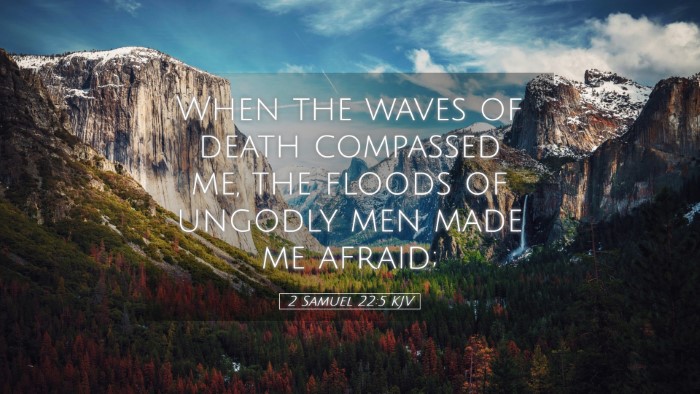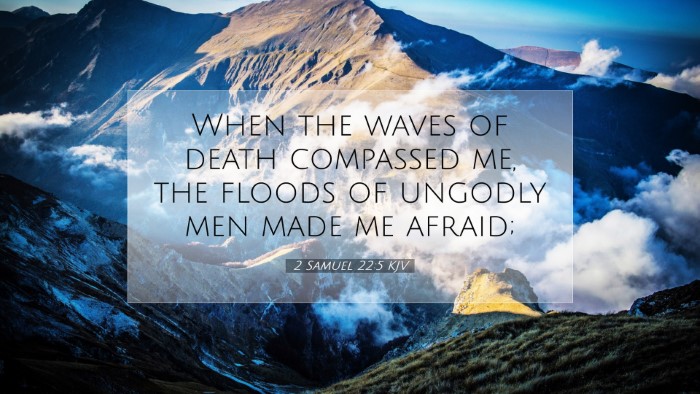Commentary on 2 Samuel 22:5
Verse (2 Samuel 22:5): "When the waves of death surrounded me, the floods of ungodliness made me afraid."
Introduction
This verse encapsulates David’s profound expression of distress, depicting a spiritual and physical struggle against overwhelming foes and circumstances. The imagery used - waves, floods, and ungodliness - evokes a sense of urgency and helplessness. Within the context of biblical commentary, we will explore the layers of meaning in this verse, drawing insights from esteemed public domain sources.
Contextual Background
Historical Setting: 2 Samuel 22 is a poetic reflection of David’s life, structured like a psalm of praise. It recounts God’s deliverance from various enemies, encapsulating David’s understanding of divine intervention in times of trouble.
Spiritual Implications: This passage serves as a reminder of the believer's experience in turmoil, where feelings of despair can arise when confronted by life’s challenges. David's language reflects the human condition—one of vulnerability and need for reliance on God.
Analysis of Key Terms
- Waves of Death: A metaphor indicating the seriousness of the threat, suggesting an enveloping, relentless force akin to natural disasters.
- Floods of Ungodliness: Depicts not only moral depravity but also the overwhelming nature of sin and opposition faced by the faithful, illustrating a spiritual battle that is deeply rooted in the struggles against sin.
- Fear: The emotion that arises from the acknowledgment of these threats. David is not only speaking of physical threats but also the spiritual and psychological anguish that accompany them.
Insights from Public Domain Commentaries
Matthew Henry's Commentary
Henry notes that David's acknowledgment of his fears does not signify a lack of faith but rather a realistic view of his circumstances. He emphasizes the important relationship between fear and faith—how awareness of danger can lead to a deeper reliance on God. As David recounts his struggles, he anticipates God’s deliverance, denoting an integral part of faith amidst tribulation.
Albert Barnes' Notes
Barnes elaborates on the vivid imagery used in this verse. He explains that "the waves of death" and "the floods of ungodliness" suggest the overwhelming forces that surround a person in times of despair. His commentary emphasizes that these phrases illustrate not just physical threats but highlight spiritual dangers, painting a picture of life's immense turmoil, which often leads to feelings of helplessness. Barnes elucidates that it is in recognizing these forces that believers can fully appreciate the nature of God’s saving grace.
Adam Clarke's Commentary
Clarke draws attention to the personal nature of David's lament. He implies that the "waves" and "floods" symbolize more than just general threats; they represent specific situations in David's life that led him to cry out for help. He emphasizes that David acknowledges calamities stemming from both physical enemies and moral failings—demonstrating the holistic view of struggle in a believer’s life. Clarke notes that understanding these terms enhances the meaning of divine rescue, showcasing the pervasive difficulties that God's people often endure.
Theological Implications
This verse encapsulates significant theological themes relevant to the Christian life:
- The Reality of Struggle: The acknowledgment of trials and tribulations is essential in the life of a believer. Recognizing that worldly challenges can evoke fear is critical for developing a mature faith.
- God as Deliverer: Despite overwhelming odds, the assurance of divine rescue is a core tenet of faith. The scripture reminds believers that God is their refuge and strength, a present help in trouble.
- Importance of Honest Lament: David's candid expression of despair encourages believers to be honest about their feelings in prayer. Laments are not just permissible, but they can be a vital aspect of spiritual life and growth.
Practical Applications
From this verse, pastors, students, and scholars can glean meaningful insights for teaching and personal reflection:
- Encouraging Vulnerability: Creating spaces for individuals to share their struggles in both personal and community settings recognizes that everyone experiences fear and anxiety.
- Building Faith in Anxiety: Teaching on reliance on God during tumultuous times through the life of David can reinforce theological teachings about God’s sovereignty and love.
- Transforming Lament into Praise: As the chapter continues, David ultimately transitions from lament to praise. Encouraging congregants to follow this pattern can help in spiritual resilience.
Conclusion
2 Samuel 22:5 serves as an eloquent reminder of the complexities of the human experience, particularly for those who pursue faith amidst trials. The insights from historical commentaries provide depth to our understanding of this passage, revealing not just David's struggle, but the universal experience of fear and hope in God. In drawing from the wells of public domain commentaries, we recognize the timelessness of scripture in addressing human emotions, calling believers to both authenticity and reliance on divine strength during life's tempestuous waves.


